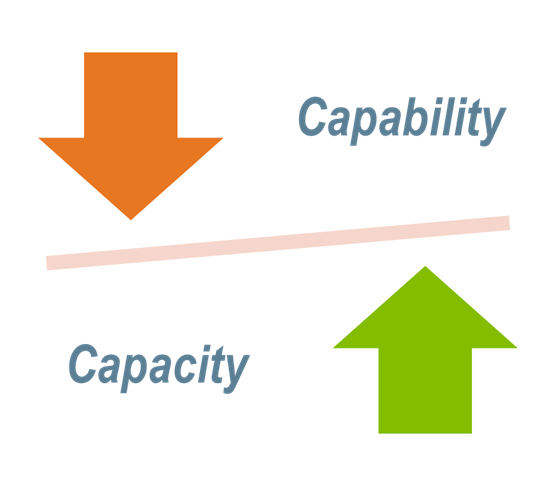I thought I would explore this topic for my post on the Manufacturing Transformation Blog. As a first step, I thought it might be helpful to first define these terms. I see supply chain capacity relating to being more of a volume measure – how much throughput can you achieve across your supply chain? Supply chain capability, on the other hand, reflects how robust and agile your supply chain is to disruptions.
At any given time, the measure of what your maximum supply chain capacity is will be a fixed figure, which could be expressed as a percentage of total capacity. Of course, over time new suppliers can be added to increase overall capacity. But, within the planning schedules of any given day or week, my assumption is that maximum capacity is a fixed constraint. The goal here is to achieve as close to 100% as you can.
Supply chain capability, however, will likely be measured in a different way – what level of redundancy do you have? Is there a single supplier that will become a bottleneck for your production process should their output decline substantially? If so, then your supply chain capability risk might be higher. The greater number of redundant suppliers you have, the less risk you have of disruption.
With regards to optimization, each of these supply chain metrics can be modeled and simulated with software, which can then dramatically help to consistently predict actual results. This is where the virtual world meets reality. Supply chain capacity can be improved by optimizing the processes utilized by your supply chain partners, to ultimately improve throughput capacity. Examples include increasing “first time right” quality as well as reducing other areas of waste, both from a process and materials perspective.
Alternatively, supply chain capability can be improved by better understanding what suppliers produce what parts, and then to model and simulate “what if” scenarios to see how disrupted or delayed order or material shortfall might do to your output. Based on the results, you might then elect to increase or modify redundancy or capability across your supply chain partners.
So, this brings me to the question: What is best to optimize?
In a perfect world, clearly it is best to analyze both metrics! But, if you were forced to choose one over the other, my recommendation would be to first evaluate and optimize your supply chain capability. The risk of failure from a capability gap could be more disruptive to your production or output plan than a decline in achieving 100% throughput of your supply chain, especially if the capability failure brings your output to a grinding halt! In other words, if evaluated from a purely risk management perspective, the potential for the greatest failure exists if your supply chain capability is inadequate. Once this risk has been managed to an acceptable level, next consider how to optimize your supply chain throughput to maximize the potential capacity, which will result in your operating with the lowest potential cost from a material, supply chain and inventory management perspective.
